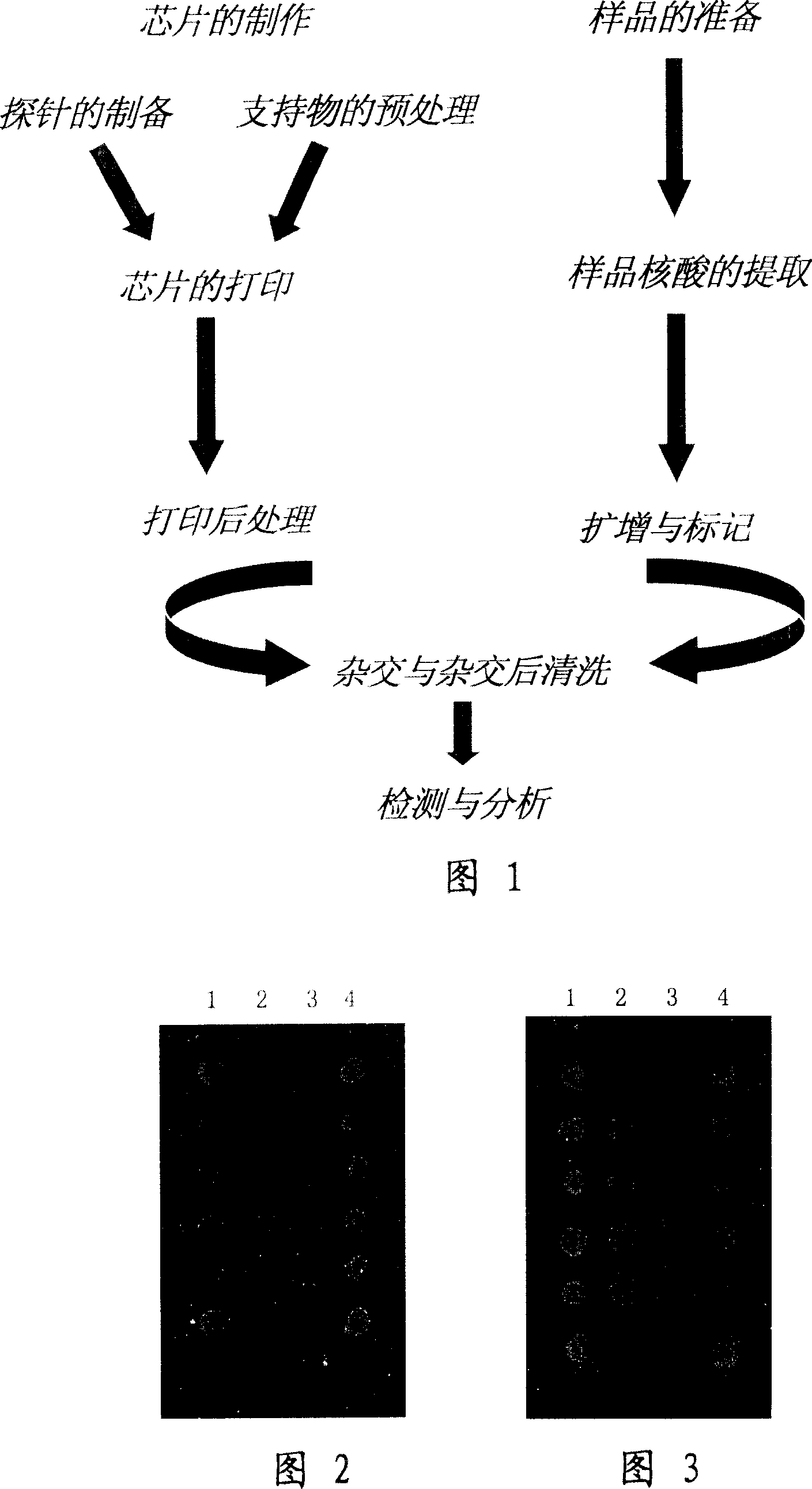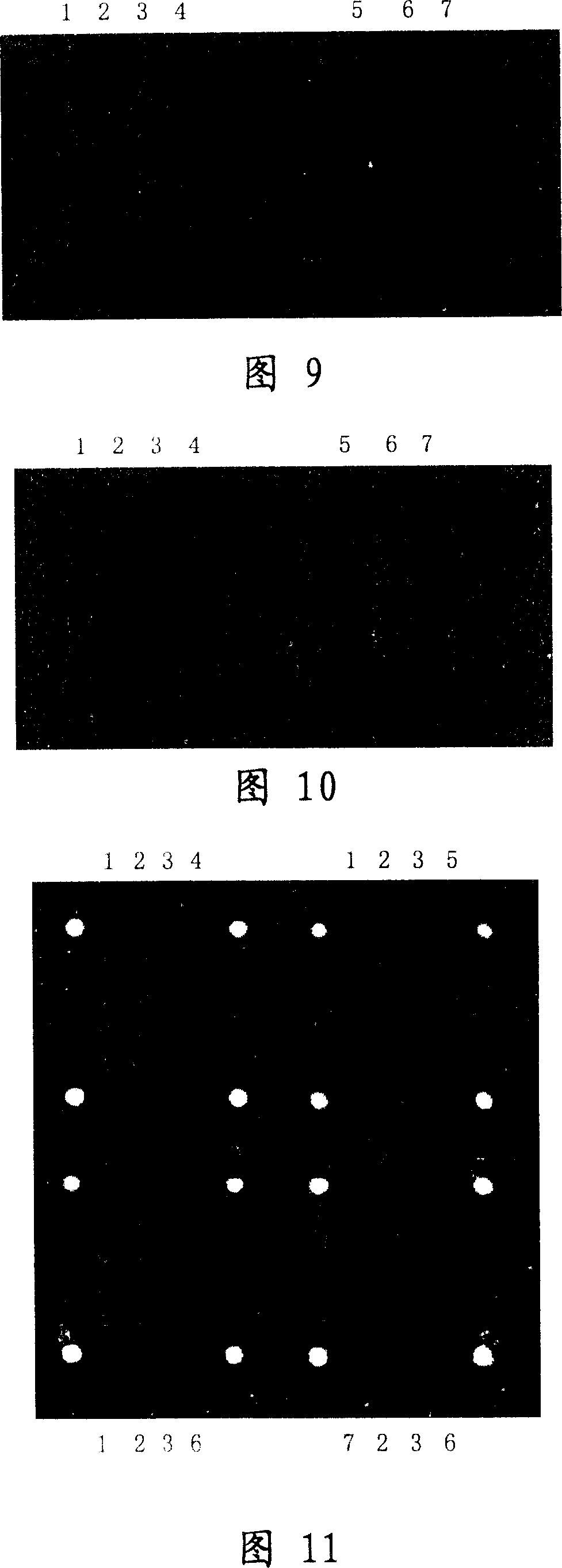Transgene agricultural product DNA detection chip, its preparation method and application
A technology for detecting chips and agricultural products, applied in biochemical equipment and methods, microbe measurement/inspection, etc., can solve the problem that chips cannot get rid of cost
- Summary
- Abstract
- Description
- Claims
- Application Information
AI Technical Summary
Problems solved by technology
Method used
Image
Examples
Embodiment 1
[0063] Example 1, Preparation of Transgenic Agricultural Products Detection Chip
[0064] 1. Extraction of genomic DNA of transgenic agricultural products (CTAB method and silica gel column purification method)
[0065] Samples and sources of genetically modified agricultural products: positive and negative samples of genetically modified soybean 40-3-2, genetically modified corn MON810, GA21, and NK603 were provided by Monsanto. Positive and negative samples of transgenic rapeseed Ms1Rf1 and T45 were provided by Bayer Company. S86-positive and negative samples of transgenic rice SCK were provided by the Institute of Genetics and Developmental Biology, Chinese Academy of Sciences.
[0066] Cetyltrimethylammonium nitrate (CTAB) extraction buffer preparation method: 20g / l CTAB, 4.0g; 4M NaCl, 16.4g; 0.1M Tris-HCl, 3.15g; 20mM sodium edetate (Na 2 EDTA), 1.5g; add 100ml of sterile deionized water, adjust the pH to 8.0 with 1M NaOH, and finally adjust the volume to 200ml and au...
Embodiment 2
[0117] Embodiment 2, the preparation of test sample
[0118] 1. Genomic DNA extraction method of the sample to be tested
[0119] For the method, refer to the "Method for Extracting Genomic DNA from Transgenic Agricultural Products" in Example 1.
[0120] 2. Labeling of samples to be tested (multiple PCR fluorescein labeling)
[0121] 25 μ l volume: PCR buffer solution, 2.5 μ l; Primer (mixed primer) table 2 and 3 listed mixed primer concentration and mixing ratio see the following specific examples); dNTP (10mM, no dTTP), 0.5 μ l; Cy5-dUTP ( 1mM) (Pharmacia), 0.5μl; dTTP (1mM), 2.0μl; template DNA (genomic DNA of the sample to be tested above), 1.0-2.0μl; Taq (5U / μl), 0.3-0.5μl; Make up to 25μl.
[0122] PCR reaction conditions: with embodiment 1.
Embodiment 3
[0123] Embodiment 3, the detection of product to be tested
[0124] 1. Hybridization and washing of slides
[0125] Steps:
[0126] (1) Place the slide in the hybridization chamber.
[0127] (2) Heat and denature the microcentrifuge tube containing the labeled probe: cook in boiling water at 100° C. for 3 minutes.
[0128] (3) Add 100 μl of high-efficiency hybridization solution (Dingguo Company) into the tube, mix well by pipetting and pour into the hybridization chamber. Hybridize at 42°C for 12-18 hours.
[0129] (4) After 12-18 hours, the slides were taken out, and put into membrane washing solution I (2×SSC, 0.1% SDS) to wash for 2 minutes.
[0130] (5) Wash the membrane with II solution (0.1×SSC, 0.1% SDS) for 2 minutes.
[0131] (6) Wash with sterile high-purity water for 2 minutes, dry and wait for scanning.
[0132] 2. Observe the hybridization results under the scanner
[0133] The test results were judged based on the signals read by a scanner (Perkin Elmer, ...
PUM
 Login to View More
Login to View More Abstract
Description
Claims
Application Information
 Login to View More
Login to View More - R&D
- Intellectual Property
- Life Sciences
- Materials
- Tech Scout
- Unparalleled Data Quality
- Higher Quality Content
- 60% Fewer Hallucinations
Browse by: Latest US Patents, China's latest patents, Technical Efficacy Thesaurus, Application Domain, Technology Topic, Popular Technical Reports.
© 2025 PatSnap. All rights reserved.Legal|Privacy policy|Modern Slavery Act Transparency Statement|Sitemap|About US| Contact US: help@patsnap.com



